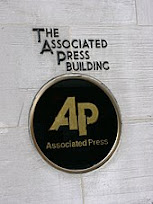The Associated Press: History and impact
All jokes aside, I have now learned that an important news agency was born many years before me, which has an impact on my future profession in journalism. On May 22, 1846 the Associated Press was created in New York City as a non-profit news cooperative. Five newspapers: The Sun, the New York Herald, the New York Courier and Enquirer, The Journal of Commerce and the New York Evening Express, banded together to afford to transmit news of the Mexican-American War. This joint effort to spread news did not stop in 1846.
Two years later, in 1848, six papers worked together to finance a telegraphic relay of foreign news brought by ships to Boston. This made Boston the first U.S. port of call for westbound transatlantic ships. The New York Associated Press got its name in 1856, and it sold its work to numerous regional newspaper organizations. Midwestern newspaper publishers created the Western Associated Press in 1862, after being pressured by regional customers to make some changes in the control of the NYAP. The Western Associated Press separated itself from the NYAP in 1892 and was established separately in Illinois as the Associated Press.
The regional organizations did not stay apart for long and merged in 1900, where the modern AP was formed. Issues occurred when a newspaper that was not a member of the AP, called the Chicago Inter Ocean, filed an anti-monopoly suit against AP. The Associated Press moved from Chicago to New York City after the Illinois Supreme Court decided that AP was a public utility that was operating in restraint of trade.
New York City was the place to be in 1900 for the Associated Press because corporation laws were more favorable to cooperatives there. AP was targeted by the Western Associated Press as well for their monopolistic news gathering and price setting practices, so it was best for them to stay on the east coast. The AP was not protected by New York corporation laws for long, when Marshall Field III, who created the Chicago Sun, fought his exclusion from the AP service in the early 1940s. Under the federal antitrust laws, prosecution put an end to AP's restrictive practices.
As technology continued to advance, so did the Associated Press. They partnered with Dow Jones & Co., Inc., to create the AP-Dow Jones Economic Report. This partnership, which formed in 1967, allowed for news about business, economic and financial information to be spread across the world.
In the '70s and '80s, the AP created DataStream, a highly efficient news transmission service; LaserPhoto, which established transmission of the first laser-scanned photos; the "electronic darkroom," which electronically formatted, cropped and transferred photos; and LaserPhoto II, the first satellite color-photograph network. The Associated Press Stylebook and Briefing on Media Law came out in 1977 and became the rulebook for news writing in the U.S.
They continued to make advancements in television, radio and video. In the '90s the Associated Press Television (renamed Associated Press Television News), a London-based global video news platform; AP All News Radio (a 24-hour radio news network); and the WIRE (an online news platform that had continuously updated audio, photos, video and text) were all created.
These advancements helped consumers become more aware of information and events developing and occurring around them. In the early 21st century AP switched their focus to including more activity from readers, such as creating a blog; asap, a multimedia news service for younger subscribers; citizen journalism; and the Mobile News Network for individuals with mobile phones.
The Associated Press has impacted the way we gain news, allowing us to gain more news from around the globe at a faster rate on various platforms. On the journalism side of things, they became a role model demonstrating what good journalism looks like, as they strive to gather and publish news efficiently, accurately and factually. They have won 58 Pulitzer Prizes, with 35 being for photography since the award was established in 1917.
The Associated Press has extremely high standards and has proven themselves to be the trailblazers of the news, with many news organizations and journalists trying to keep up with them.
Their stylebook is acclaimed by many, with a lot of organizations turning to it, to run their organizations properly. The work of the Associated Press has ultimately gotten the ball rolling to make the news clearer and more concise for readers, by being a standard of good journalism practice, that other organizations strive to be like.
I will certainly use the Associated Press Stylebook in my future profession, and I look forward to reading the AP as reference to work on configuring efficient, accurate and unbiased news pieces for many audiences around the world.




No comments:
Post a Comment